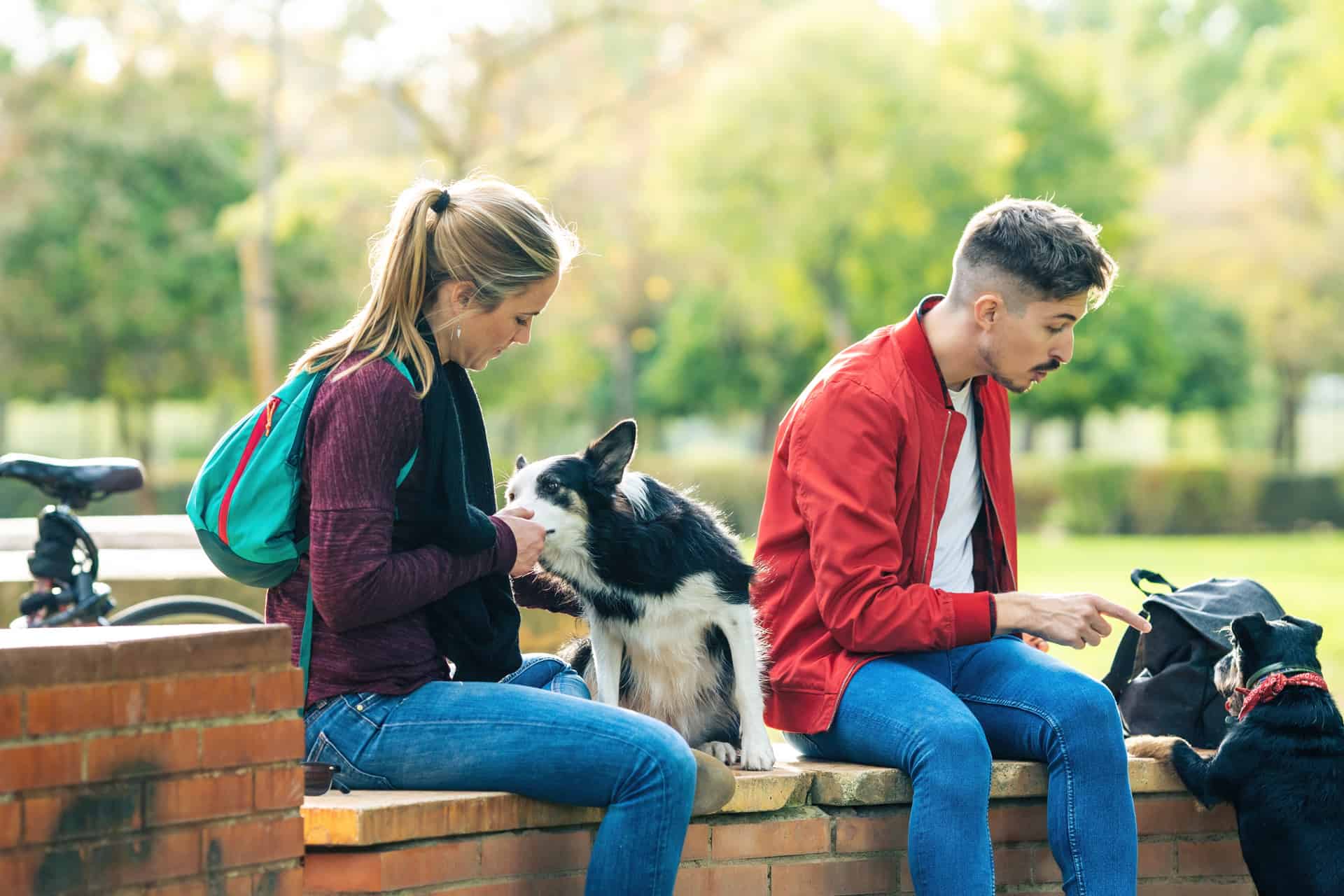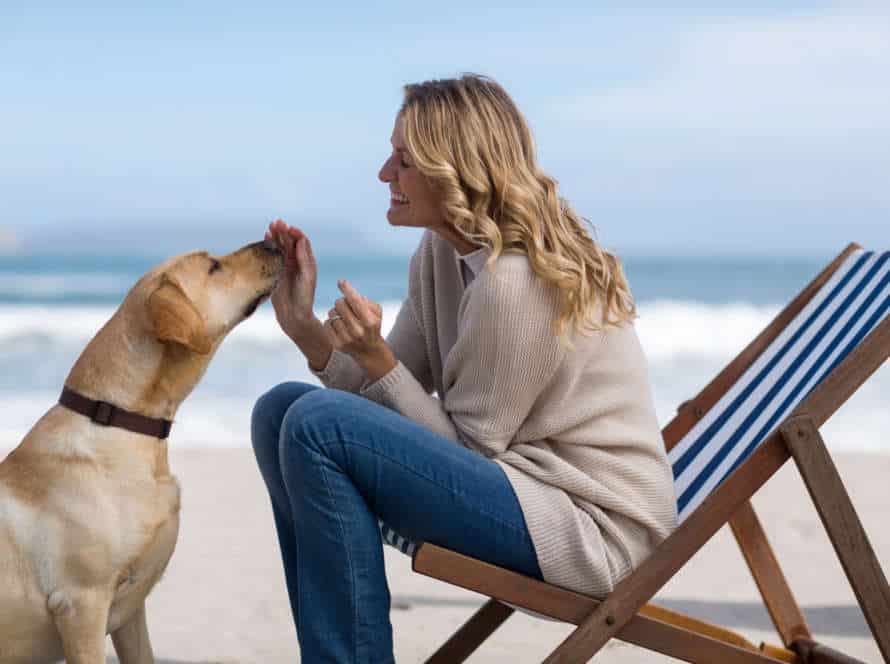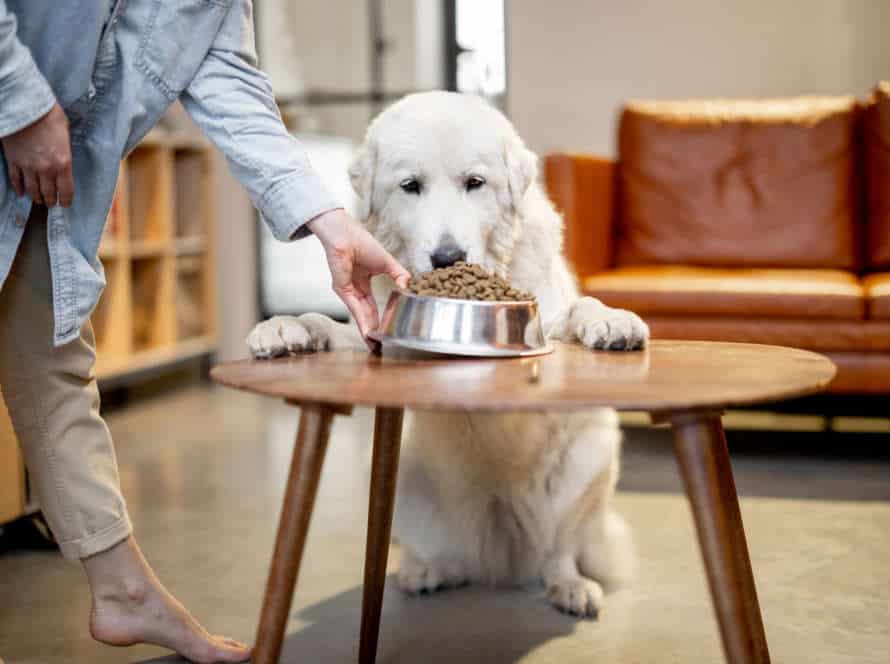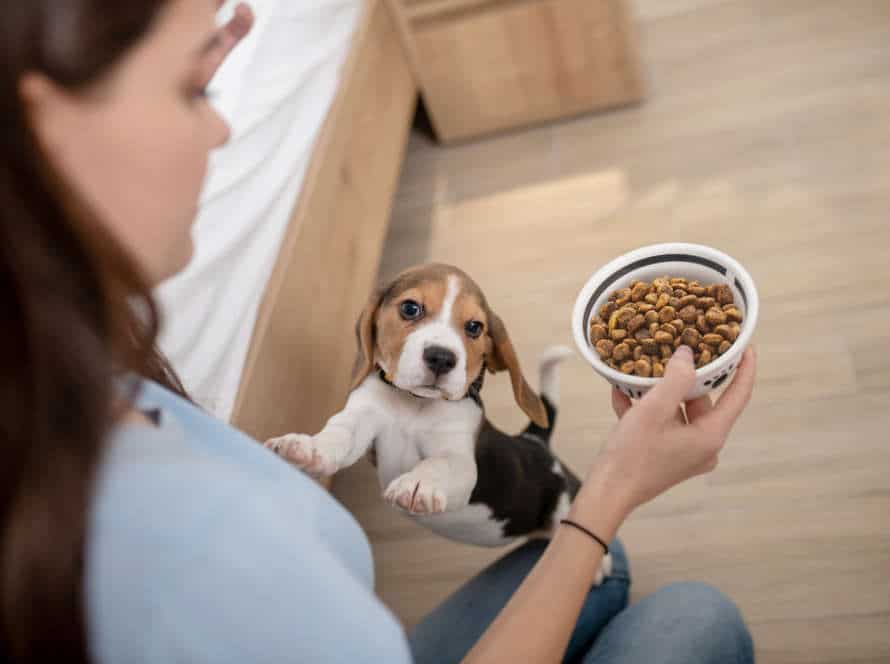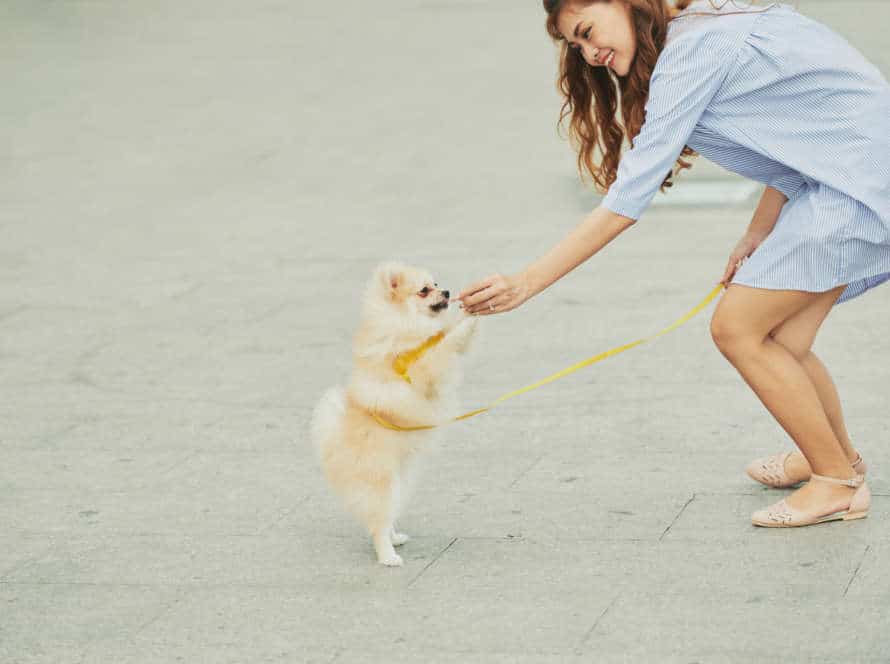Mastering Positive Reinforcement Training for Adult Dogs
Positive reinforcement training is a great way to teach adult dogs new tricks and reinforce existing ones. Here are some tips to help you master it:
- Be consistent. Use the same commands and rewards every time.
- Give high-value treats. Use treats like cooked chicken or cheese that your dog loves.
- Time rewards right. Reward your pup right away when they do the right thing.
- Keep sessions short and frequent. Adult dogs have short attention spans, so focus on one behavior at once.
- Most importantly, be patient and trust-building with your pup. Always reward good behavior.
Understanding Positive Reinforcement
Positive reinforcement is a great way to train adult dogs. Reward desired behavior and you’ll notice more of it! To use positive reinforcement properly, you need to know the basics. Here’s all about understanding and applying positive reinforcement for dogs that are a bit older.
Definition and benefits of positive reinforcement training
Positive reinforcement training is a great method! It involves rewarding your pup’s good behavior. Treats, praise, affection, and playtime are all good rewards. This approach is much better than punishment-based methods. It builds trust, confidence, and mutual respect. Plus, there are lots of benefits! A happy, confident pup, a strong bond between you two, and a safe, stress-free environment. You can also use this technique to teach complex behaviors, tricks, and correct bad behavior.
Pro tip: Pick rewards your pup loves and keep training sessions short and consistent for best results.
The science behind positive reinforcement
Positive reinforcement is a great way to train your dog. It’s scientifically proven, humane and fun for both you and your pup. You reward their good behaviours with something they value, like treats or kind words.
The science behind positive reinforcement is that it makes positive associations in a dog’s mind. When they do something right and get rewarded, dopamine is released which makes them feel good. This encourages the behaviour to happen again.
To master this training for adult dogs, you need to:
- Figure out what motivates them, like treats or toys.
- Be consistent in rewarding good behaviours.
- Avoid punishing bad behaviours and instead redirect their attention to something good and reward that.
By using positive reinforcement, you can train your adult dog effectively, creating a strong bond between you two. Plus, it won’t cause your pup any stress or harm.
Comparison with other training methods
Positive reinforcement training is a popular, humane, and effective way to train adult dogs. It’s better than punishment-based techniques or dominance theory.
Firstly, it encourages desirable behavior, not punishing unwanted behavior. This creates a positive and low-stress environment and strengthens the bond between you and your pet.
Secondly, it’s more effectual in creating lasting behavior change. Dogs are motivated to repeat desired behaviors, not avoid negative consequences.
Thirdly, it can teach a wide range of behaviors. From simple commands to complex tricks and behaviors. It’s ideal for owners who want to improve their dog’s behavior and enrich their pet’s life.
Pro tip: Be consistent and patient with positive reinforcement training. Dogs require routine and rewards (treats or praises) when exhibiting desired behavior.
Setting Goals for Training
Wanna help your pup learn faster? Positive reinforcement training is the way to go! Understand your dog’s needs and abilities first. Then, set achievable goals that suit your pup’s capacity. Here’s some tips for setting attainable goals for positive reinforcement training. Your pup will thank you for it!
Assessing your dog’s behavior and needs
Assess your pup’s habits and needs! It’s the first step for training and mastering positive reinforcement.
Here are some things you can do to assess your pup’s habits and needs:
- Observe your pup’s body language, reactions to different things, and interactions with you and others.
- Figure out any bad behaviors, such as too much barking or jumping.
- Discover their preferences like favorite toys, treats, and activities.
- Think about their breed, age, health, and past experiences.
When you know your pup’s behavior and needs, you can set achievable goals and make a positive reinforcement plan that fits your pup’s character and learning style.
Determining what behaviors you want to reinforce
To master positive reinforcement for adult dogs, setting specific training goals is a must. Begin by determining the behaviors you want to reinforce in your pup.
- Step 1: Observe your dog’s habits. Barking too much? Jumping on people? These are behaviors that need improvement.
- Step 2: Make goals, like sitting, responding to commands and leash training.
- Step 3: Reward good behavior with treats or praise. This teaches your dog that good behavior is rewarded.
Positive reinforcement takes time, patience and consistency. Setting goals is the first step to developing a strong connection with your dog, obedience and harmony.
Pro Tip: Don’t reward bad behavior – it could ruin the training program!
Setting realistic goals and expectations
Setting realistic goals and expectations is a must for successful adult dog training with positive reinforcement. Unrealistic ones lead to frustration and inadequate training.
Here are some tips for setting realistic goals:
- Start small – ‘sit’ and ‘stay’ first. Then ramp up to more complex behaviors.
- Have a clear objective – Break down the behavior into small, achievable parts.
- Acknowledge progress – Celebrate even the small victories to encourage good behavior.
- Be flexible – If your pup has trouble, adjust the plan and stay consistent.
Remember, positive reinforcement training needs persistence, patience, and a picture of the end goal. Pro tip: Consulting a pro trainer helps to set realistic goals, make a personalized plan, and give expert help and feedback.
Positive Reinforcement Techniques
Positive reinforcement is a popular and reliable way to train adult canines. This technique focuses on rewarding good actions, which will make the dog repeat them. Moreover, it strengthens the bond between the pup and its owner. To guarantee success, it is crucial to comprehend the various strategies of positive reinforcement for adult pooches. Let’s explore the most widely-used methods!
Reward-based training methods
Reward-based training is a great way to train adult dogs. It focuses on rewarding good behaviors and ignoring or redirecting bad ones. Here are some positive reinforcement methods:
- Treats! Give small, bite-sized treats right after they do something good. This will help them understand the reward.
- Clicker Training. Use a small clicking noise to signify a good behavior. Then, give them a treat. This will make them connect the clicking noise with the reward.
- Verbal Praise. Positive reinforcement can be a happy “good job” or “well done“.
By consistently rewarding good behaviors, your dog will learn to associate rewards with good behaviors. Pro tip: Be consistent!
Using treats, toys, and praise as rewards
Positive reinforcement is an effective technique for training adult dogs. Here’s how: when your pup does something good, give them a reward! It could be a treat, toy, or praise–consistency is key.
Once the behavior is mastered, you can start reducing rewards. Positive reinforcement should focus on rewarding positive behavior, not punishing negative behavior.
Using treats, toys, and praise will create a positive environment where your dog associates good behavior with good results. Pro tip: use “high-value” treats and toys like meat or Kongs filled with peanut butter to keep your pup interested and motivated.
Timing and consistency for effective reinforcement
Timing and consistency are essential for successful dog training with positive reinforcement.
- Timing: Rewards must be given ASAP when the desired behavior is exhibited. So the dog links the reward to the behavior.
- Consistency: Rewards need to be frequent and equal, so the dog knows what’s expected.
- Plus, the rewards should be something the dog values, to keep them motivated.
When you get the timing, consistency and value right, positive reinforcement can help adult dogs learn good habits.
Luring and shaping
Luring and shaping are two great techniques to train adult dogs humanely and effectively. Luring uses a treat or reward to guide your pup, by holding food close to their nose and moving it in the desired direction. Shaping breaks complex behaviors into small steps and rewards each one until you get the behavior you want. For example, when teaching to catch a frisbee, you’d start by rewarding just for looking at it, then taking a step towards it, then touching it with their nose, and so on.
These methods make training fun and rewarding for both you and your pup. Pro Tip: Use yummy treats like meat, cheese, or liver to make the process even more effective!
Using lures to teach basic commands
Lures are great for teaching adult dogs basic commands. A lure is something tasty they follow with their nose and mouth. Here’s how to use lures:
- Choose your pup’s favorite treat.
- Show it to them and let them sniff it.
- Move it slowly up and back, so they sit.
- Give the treat and praise.
- Do this with other commands like “down,” “come,” and “stay.”
- Replace food with hand signals and verbal cues as your pup learns the commands.
- Be consistent and patient for positive results and a great bond.
Pro tip: Use small, easily eaten treats to avoid overfeeding your dog during training.
Shaping behaviors through incremental training
Train adult dogs in the most successful way by using incremental training.
Break down the required behavior into small steps.
Reward your pup with treats, compliments, or fun activities when it completes each step.
When your pup is good at the step, make it more difficult and add new steps.
By giving consistent and progressive rewards for great behavior, you can form your dog’s habits and promote positive ones.
Positive Punishment vs Negative Reinforcement
Positive punishment and negative reinforcement are two distinct methods of dog training. Each has its pros and cons. Positive reinforcement is the most effective for adult dogs.
Positive punishment involves adding an unpleasant stimulus to reduce unwanted behavior. Examples include shock collars, physical corrections, and verbal reprimands. This may seem to work, but can cause aggression and anxiety in dogs.
Negative reinforcement is the removal of an aversive stimulus to boost desired behavior. Examples include leash tugs, choke collars, and ear pinches. While this can work, it also increases stress for the dog and can damage the relationship.
Positive reinforcement uses rewards to motivate good behavior. Treats, praise, and playtime can all be used as rewards. This creates a bond between you and your pet, and makes them more likely to learn.
Pro Tip: Always use positive reinforcement with adult dogs. Avoid punishment-based methods that could harm your pet’s mental health.
Understanding the risks and consequences of punishment-based training
Punishment-based training techniques involve correcting bad behaviors with physical or verbal punishment. This kind of training has negative effects on your dog’s psychological and emotional well-being.
Risks for adult dogs include increased anxiety, fear, and aggression towards their owner, other animals, or strangers. Dogs trained this way are more likely to develop chronic stress, destructiveness, and attention-seeking behaviors.
These negative behaviors can worsen over time as the dog becomes desensitized or has a strong aversive reaction to punishment.
Positive reinforcement techniques, such as clicker training, can be used instead. This encourages desirable behaviors through rewards and incentives rather than punishment. It builds a positive and trusting bond between dog and owner and can lead to more lasting, effective training results.
Pro tip: Always focus on rewarding good behavior rather than punishing bad behavior when training your dog. This method is more effective and gentle.
Training alternatives to avoid punishment
Positive reinforcement training is an effective and humane way to train adult dogs without punishment. Here are some techniques to use:
- Clicker Training: Use a clicker to signal when they do the desired behavior. Then, give a treat reward.
- Treat Training: Give small, non-greasy treats right away when they do the right thing.
- Praise Training: Give positive attention with affectionate words, pats, or hugs.
- Repetition Training: Be consistent. Reward and praise them for good behavior.
Troubleshooting Common Problems
Positive reinforcement training for adult pooches can be a great tool to help them learn fast. But, it can be tricky to use, and you might encounter some issues. Let’s discuss common problems that arise when using positive reinforcement to train your dog, plus how to fix them.
Dealing with stubborn or difficult dogs
Dealing with stubborn or difficult doggos can be tricky. To help them overcome their problem behavior, you need patience and positive reinforcement training. Here’s what to do:
- Figure out why they’re behaving like this – could be boredom or anxiety?
- Praise ’em and give rewards when they do good.
- Stay consistent with training – no punishment or negative reinforcement.
- Exercise and stimulate their mind – keep them active.
- If the problem persists, get professional advice or training.
- Don’t forget – your pup’s behavior isn’t your fault! With the right attitude and effort, you’ll help your pup become a happy family member.
Pro Tip: If nothing else works, try changing your training methods or enrolling in obedience classes with your pup!
Addressing fear and anxiety
Addressing fear and anxiety in adult dogs can be tough. But, with the right training and positive reinforcement techniques, it’s achievable! Here are some common problems and tips for mastering positive reinforcement training for adult dogs.
Separation Anxiety:
This is a common issue. It can lead to destructive behaviours, excessive barking and even accidents. To address it, gradually increase the time you’re away from your pup. Use positive reinforcement techniques, like giving treats, toys or puzzle feeders to keep them occupied when alone.
Fear of Loud Noises:
Dogs can be scared of loud noises like fireworks, thunder or construction sounds. Counter-conditioning and desensitization training in a safe, controlled environment can help. Use positive reinforcement techniques like treats, a soothing voice and toys.
Leash Aggression:
Leash aggression can be caused by fear, stress or previous negative experiences. To address it, use positive reinforcement techniques to reward calm and focused behaviour. Re-direct attention or teach alternative behaviours, and gradually expose them to triggers in a controlled and safe environment.
Patience, consistency and positive reinforcement techniques can help tackle even the most challenging behaviours in adult dogs.
Overcoming distractions and maintaining focus
When training an adult dog, distractions can be a problem. To beat them, take these steps!
- Pick a quiet, familiar spot.
- Use treats they love.
- Train in shorter, more frequent sessions.
- Exercise and play to help release energy.
- Keep the training consistent and structured.
Patience is key. With these tips and consistency, your furry friend can stay focused!
Advanced Techniques and Applications
Positive reinforcement training is a great way to teach adult dogs new behaviours. If you reward your pup with treats, pats or kind words, they’ll be more likely to repeat the behaviour. In this article, we’ll explore some of the top techniques and uses for this type of training with grown-up dogs.
Proofing behaviors and adding complexity to training
Proofing behaviors and making training more complex is an advanced technique used to perfect positive reinforcement training for adult dogs. After teaching your dog a behavior, proof it by adding distractions or increasing difficulty. This helps your dog remember the behavior and do it in different situations.
Examples of proofing behaviors:
- Distraction training: Add new noises or scents to the training area. This helps your dog stay focused and get used to different environments.
- Distance training: Practice the behavior from a distance. Gradually make the distance bigger to make the task harder.
- Duration training: Make the behavior last longer. This builds up your dog’s focus and stamina.
By proofing behaviors and making training more complex, your dog will be better at responding to commands and be a great companion.
Using positive reinforcement in real-life scenarios
Positive reinforcement is a powerful technique to train your adult dog. Use it to teach good behavior and reinforce existing ones. Here are scenarios where you can get excellent results:
- When your dog walks calmly beside you on a leash, reward them with a treat or verbal praise.
- Ask your dog to sit at doorways before proceeding. Give them praise or a treat when they do.
- When meeting new people, offer a treat if the dog is calm & well-mannered.
- When it’s time for bed, reward them with a treat or praise.
Be consistent & use positive reinforcement only. Avoid punishment or negative reinforcement. Praise & treats are key to successful training!
Reinforcing good behavior for long-term success
Positive reinforcement is an effective way to train adult dogs. It’s essential for successful long-term training. Here’s how to master it:
- Give rewards for good behavior, like treats, praise and play.
- Use a positive and consistent tone of voice and body language.
- Reinforce immediately so your dog connects the reward with the behavior.
- Shape behavior by breaking it into smaller steps.
- Chain multiple behaviors into a sequence.
Positive reinforcement training has a big impact, but it needs time and patience. Use these techniques to get great results!
Frequently Asked Questions
1. What is positive reinforcement training for adult dogs?
Positive reinforcement training is a method of training where dogs are rewarded for good behavior rather than punished for bad behavior. This training involves using treats, toys, and other rewards to encourage desired behavior, such as sitting or staying.
2. Can positive reinforcement training be used for adult dogs?
Yes, positive reinforcement training can be used for adult dogs. In fact, many experts consider it to be the most effective method of training for dogs of all ages.
3. How long does it take to master positive reinforcement training for adult dogs?
The time it takes to master positive reinforcement training for adult dogs depends on several factors, including the dog’s age, temperament, and prior training experiences. However, with patience, consistency, and practice, most owners can start to see positive results within a few weeks.
4. Are there any potential downsides to using positive reinforcement training with adult dogs?
While positive reinforcement training is generally considered safe and effective, there are some potential downsides to using this method of training. For example, if you rely too heavily on treats and rewards, your dog may become overly focused on getting them, which can lead to behavioral problems or obesity.
5. How can I get started with positive reinforcement training for my adult dog?
To get started with positive reinforcement training, you will need to find a qualified trainer or do your research and learn how to do it yourself. You will also need to invest in some key supplies, such as high-quality treats and toys, as well as a clicker or other training aid.
6. What are some common mistakes to avoid when using positive reinforcement training with adult dogs?
Some common mistakes to avoid when using positive reinforcement training with adult dogs include over-relying on treats, failing to understand or address underlying behavior problems, and inconsistently applying the training methods. It is important to work closely with a qualified trainer, read up on positive reinforcement training strategies, and stay patient and persistent throughout the process.

